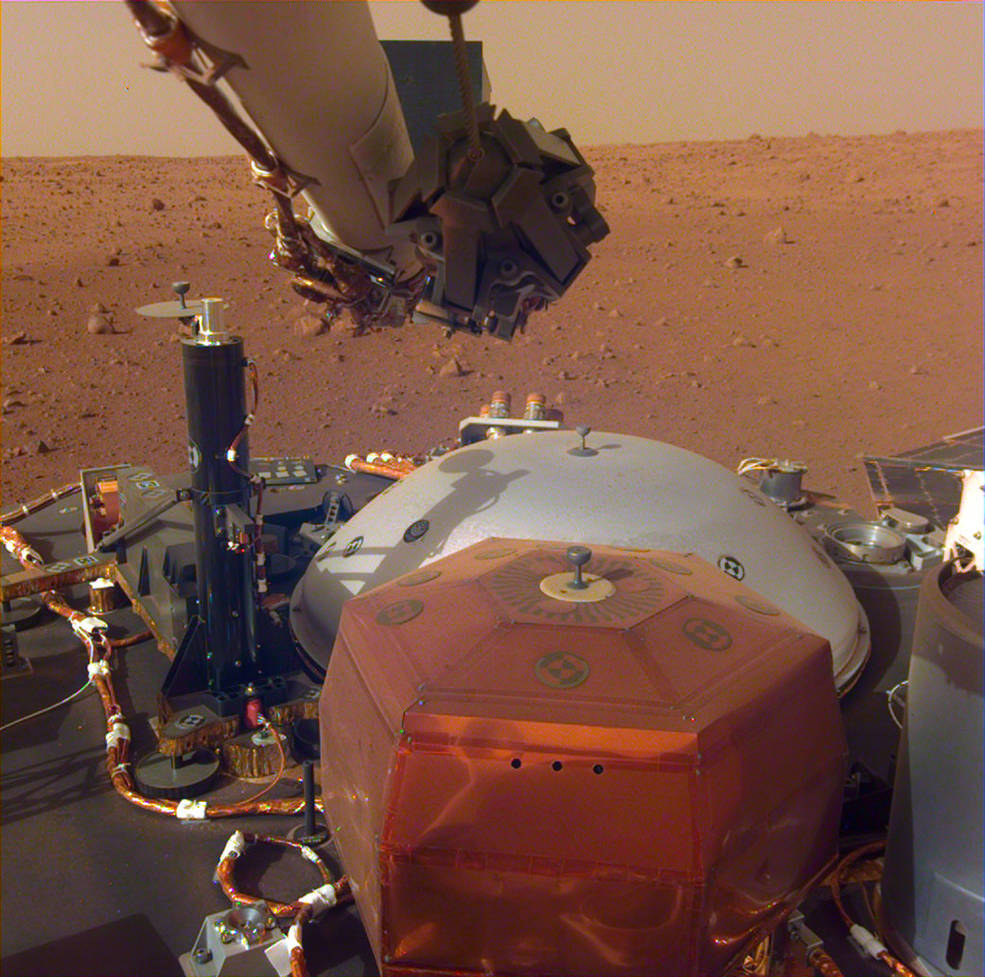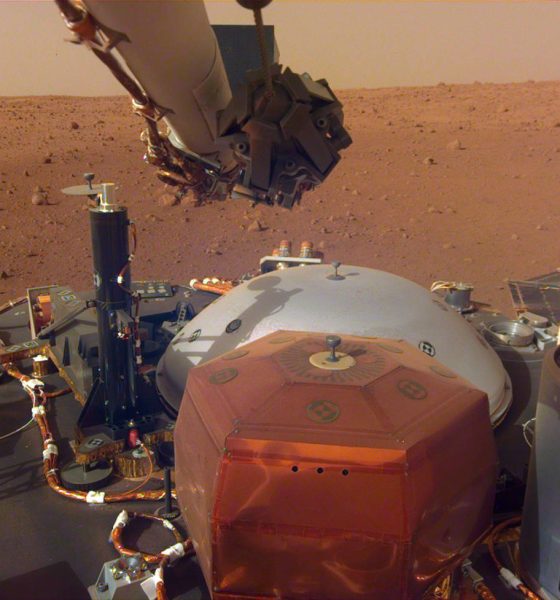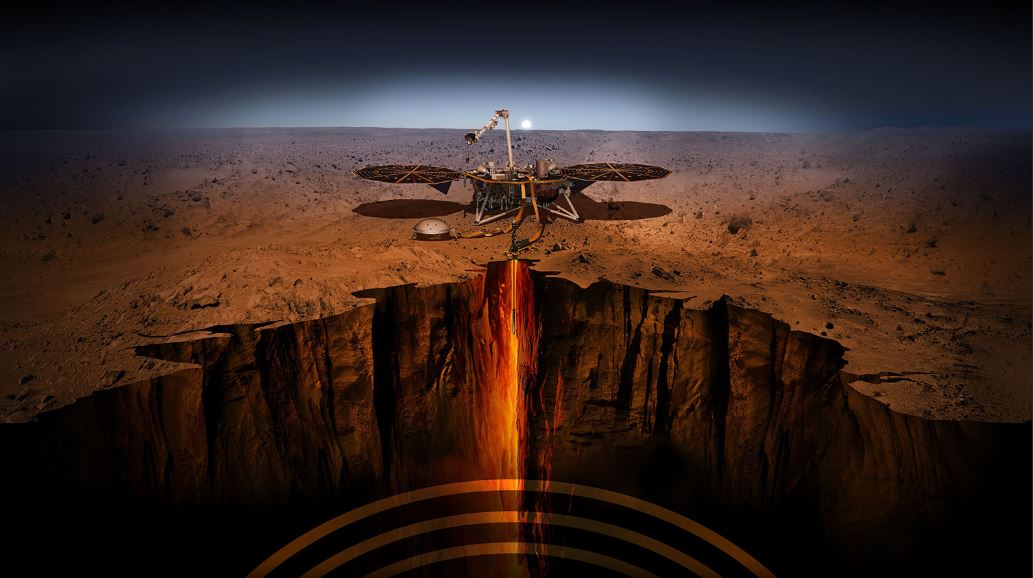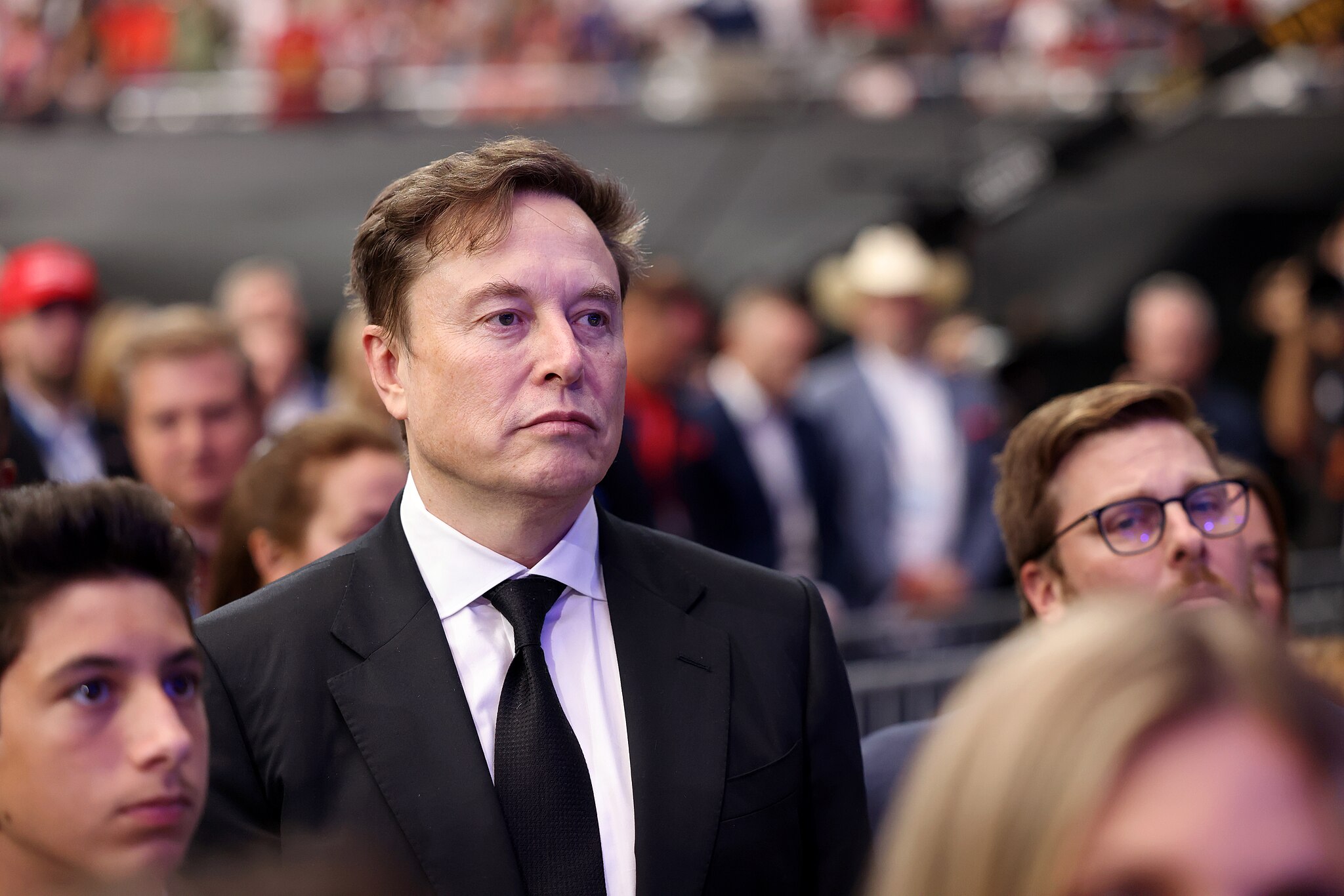

News
First sounds of wind on Mars captured by NASA’s Insight Lander
This fresh in from the Elysium Planitia of Mars: the sound of wind from an alien world. On its 10th day as a new resident of the red planet, NASA’s InSight lander’s pressure sensor transmitted air vibration data from its trembling solar panels, representing a steady breeze about 99 million miles away. The combination of photos sent back from the craft with the sound of Martian wind gives Earth residents a unique moment to feel like they’ve joined the craft themselves. “It’s fun to imagine that I’m there,” mused Don Banfield during a JPL media teleconference discussing the recording. Banfield is InSight’s Auxiliary Payload Sensor Subsystem (APSS) Science Lead.
InSight, short for “Interior Exploration using Seismic Investigations, Geodesy and Heat Transport”, launched aboard an Atlas V rocket on May 5, 2018 and successfully landed on the Martian surface on November 26, 2018. The craft is a seismic investigator sent to study the red planet’s core, eventually drilling 10-16 feet down into its crust to gather geographical data. The craft’s landing event was live streamed online for viewers around the world, greeting Earthlings with a photo of its new home’s surface shortly after. It sent back more photos of the surrounding area prior to the wind recording.
The thin CO2 atmosphere on Mars doesn’t translate high sounds well, so the recorded vibrations from InSight’s pressure sensor are low on the audio spectrum, under 50 Hz, thus difficult to hear. However, after the frequency was increased by a factor of 100 (raised two octaves), it became possible to hear what sounds like a steady wind blowing across the regolith. Dust devils tracked in the area moving across the Martian surface had motion consistent with the wind recordings, thus confirming what was being heard by InSight’s scientists.

The way InSight picks up and translates sound is similar to how a human ear works: Air pressure vibrates the eardrum, then that vibration pattern is sent through the inner ear bones to the cochlea which has tiny hairs translating the vibrations into electrical signals sent to the brain. InSight’s solar panels are like its eardrums, the spacecraft structure itself like its inner ear, its instruments like its cochlear, and its electronic box translating and transmitting signals is like brain. The “sounds” we hear from Mars are translated data from wind-caused vibrations.
Ironically enough, wind noise is actually not a particularly desired outcome from InSight’s instruments. According to the scientists participating in NASA’s teleconference discussing the event, the inlet for the pressure sensor was specifically designed to minimize any chatter from air movement. Also, the placement of InSight’s seismographic gear will be based on the best area to reduce input from the lander’s interaction with the vibrations it’s recording, i.e., the lander’s movement from seismic events. It should be noted, though, the Martian wind gracing our human ears for the first time is only a taste of what’s to come from InSight’s instruments.
Once the wind and thermal shield (the white dome in the photos) has been lifted from the lander in a few weeks, all of InSight’s instruments will be exposed to the Martian environment for data collection. For now, the lander’s Earth-based team is first focusing on understanding the area the craft is in to pick the best place to set its instruments. After the main mission begins, however, a full study of Mars’ atmosphere will be underway and we could hear, among other natural events, the sounds of exploding meteors.

While wind may be a unique sound to hear on an alien world, it’s not the first time a NASA craft has entertained our ears and imaginations. Electromagnetic vibrations have been recorded all across our solar system, perhaps the most famous of which originated from the Voyager 1 spacecraft launched in 1977. The data collected from the craft’s radio-capturing instruments has been converted into audio files – you can even find a full album’s worth of the sounds on a variety of streaming sites. Some of the recordings are meditation-worthy, others a touch unnerving. We humans have additionally added some recordings of our own to space via Voyager’s famous “golden record”, the sounds of which are also available for listening online.
If you’re craving a full Martian soundtrack, you’ll be happy to know that NASA’s Mars 2020 rover is planned to provide just that. It will have two microphones on board, one of which will record the actual landing of the rover. Combined with telemetry data and surface photographs, Mars is on its way to its own documentary with inputs completely provided “on-location”. Stay tuned!
Listen to the Martian wind yourself below:

Elon Musk
Judge clears path for Elon Musk’s OpenAI lawsuit to go before a jury
The decision maintains Musk’s claims that OpenAI’s shift toward a for-profit structure violated early assurances made to him as a co-founder.

A U.S. judge has ruled that Elon Musk’s lawsuit accusing OpenAI of abandoning its founding nonprofit mission can proceed to a jury trial.
The decision maintains Musk’s claims that OpenAI’s shift toward a for-profit structure violated early assurances made to him as a co-founder. These claims are directly opposed by OpenAI.
Judge says disputed facts warrant a trial
At a hearing in Oakland, U.S. District Judge Yvonne Gonzalez Rogers stated that there was “plenty of evidence” suggesting that OpenAI leaders had promised that the organization’s original nonprofit structure would be maintained. She ruled that those disputed facts should be evaluated by a jury at a trial in March rather than decided by the court at this stage, as noted in a Reuters report.
Musk helped co-found OpenAI in 2015 but left the organization in 2018. In his lawsuit, he argued that he contributed roughly $38 million, or about 60% of OpenAI’s early funding, based on assurances that the company would remain a nonprofit dedicated to the public benefit. He is seeking unspecified monetary damages tied to what he describes as “ill-gotten gains.”
OpenAI, however, has repeatedly rejected Musk’s allegations. The company has stated that Musk’s claims were baseless and part of a pattern of harassment.
Rivalries and Microsoft ties
The case unfolds against the backdrop of intensifying competition in generative artificial intelligence. Musk now runs xAI, whose Grok chatbot competes directly with OpenAI’s flagship ChatGPT. OpenAI has argued that Musk is a frustrated commercial rival who is simply attempting to slow down a market leader.
The lawsuit also names Microsoft as a defendant, citing its multibillion-dollar partnerships with OpenAI. Microsoft has urged the court to dismiss the claims against it, arguing there is no evidence it aided or abetted any alleged misconduct. Lawyers for OpenAI have also pushed for the case to be thrown out, claiming that Musk failed to show sufficient factual basis for claims such as fraud and breach of contract.
Judge Gonzalez Rogers, however, declined to end the case at this stage, noting that a jury would also need to consider whether Musk filed the lawsuit within the applicable statute of limitations. Still, the dispute between Elon Musk and OpenAI is now headed for a high-profile jury trial in the coming months.
News
Tesla Giga Shanghai celebrates 5 million electric drive unit milestone
The milestone was celebrated by the company in a post on its official Weibo account.

Tesla China has reached another manufacturing milestone at Gigafactory Shanghai, rolling out the facility’s 5 millionth locally produced drive unit.
The milestone was celebrated by the company in a post on its official Weibo account. In its post, the Giga Shanghai team could be seen posing with the 5 millionth drive unit.
Giga Shanghai’s major benchmark
The milestone drive unit was produced at Gigafactory Shanghai, which produces the Model Y and the Model 3. In a release, Tesla China noted that its three-in-one integrated electric drive system combines the motor, gearbox, and inverter into a single compact assembly. This forms a powerful “heart” for the company’s electric cars.
Tesla China also noted that its drive units’ integrated design improves energy conversion efficiency while reducing overall weight and complexity, benefits that translate into stronger performance, improved handling, and longer service life for its vehicles.

The new milestone builds on earlier achievements at the same site. In July 2024, Tesla announced that its 10 millionth electric drive system globally had rolled off the line at the Shanghai plant, making it the first self-produced Tesla component to reach that volume.
More recently, the factory also produced its 4 millionth China-made vehicle, a Model Y L. The factory has also continued hitting global production milestones, rolling out Tesla’s 9 millionth EV worldwide late last year, with the landmark vehicle being a Tesla Model Y.
Tesla China’s role
Construction of Giga Shanghai began in January 2019, with production starting by the end of that year. This made it the first wholly foreign-owned automotive manufacturing project in China. The facility began delivering Model 3 vehicles locally in early 2020 and added Model Y production in 2021. The plant is now capable of producing about 1 million vehicles annually.

Throughout 2025, Giga Shanghai delivered 851,732 vehicles, representing a 7.08% year-on-year decline, according to data compiled by CNEVPost. Even so, recent months showed renewed momentum.
In December alone, Tesla China recorded wholesale sales of 97,171 vehicles, including domestic deliveries and exports, making it the company’s second-best monthly total on record, per data from the China Passenger Car Association. Retail sales during December reached roughly 94,000 units, up about 13% year over year.
Investor's Corner
Tesla price target boost from its biggest bear is 95% below its current level

Tesla stock (NASDAQ: TSLA) just got a price target boost from its biggest bear, Gordon Johnson of GLJ Research, who raised his expected trading level to one that is 95 percent lower than its current trading level.
Johnson pushed his Tesla price target from $19.05 to $25.28 on Wednesday, while maintaining the ‘Sell’ rating that has been present on the stock for a long time. GLJ has largely been recognized as the biggest skeptic of Elon Musk’s company, being particularly critical of the automotive side of things.
Tesla has routinely been called out by Johnson for negative delivery growth, what he calls “weakening demand,” and price cuts that have occurred in past years, all pointing to them as desperate measures to sell its cars.
Johnson has also said that Tesla is extremely overvalued and is too reliant on regulatory credits for profitability. Other analysts on the bullish side recognize Tesla as a company that is bigger than just its automotive side.
Many believe it is a leader in autonomous driving, like Dan Ives of Wedbush, who believes Tesla will have a widely successful 2026, especially if it can come through on its targets and schedules for Robotaxi and Cybercab.
Justifying the price target this week, Johnson said that the revised valuation is based on “reality rather than narrative.” Tesla has been noted by other analysts and financial experts as a stock that trades on narrative, something Johnson obviously disagrees with.
Dan Nathan, a notorious skeptic of the stock, turned bullish late last year, recognizing the company’s shares trade on “technicals and sentiment.” He said, “From a trading perspective, it looks very interesting.”
Tesla bear turns bullish for two reasons as stock continues boost
Johnson has remained very consistent with this sentiment regarding Tesla and his beliefs regarding its true valuation, and has never shied away from putting his true thoughts out there.
Tesla shares closed at $431.40 today, about 95 percent above where Johnson’s new price target lies.








